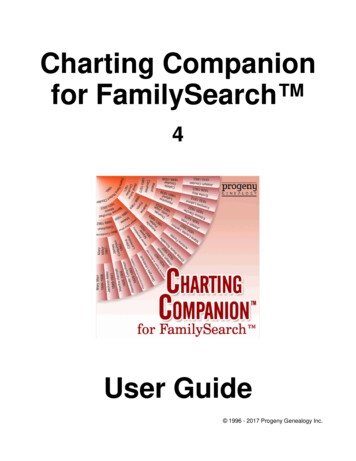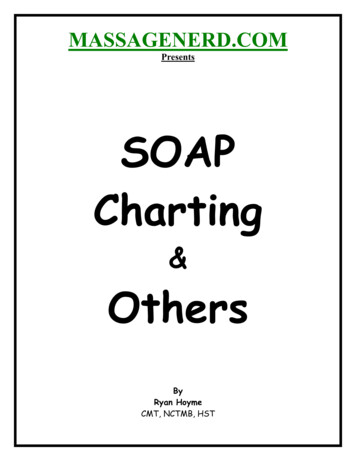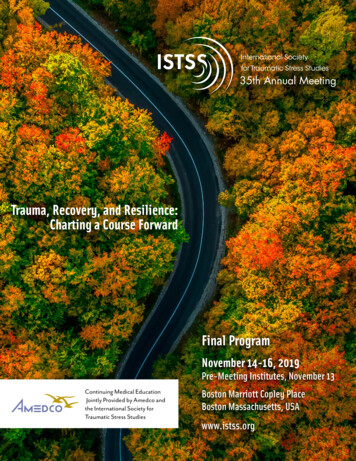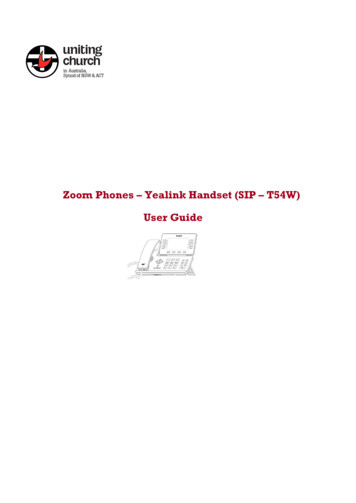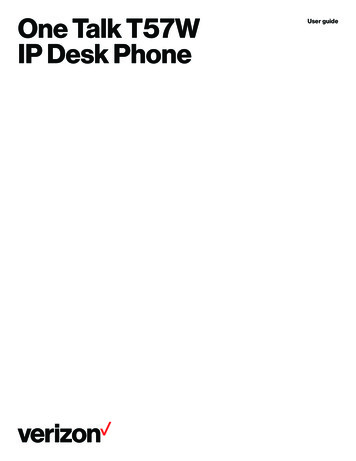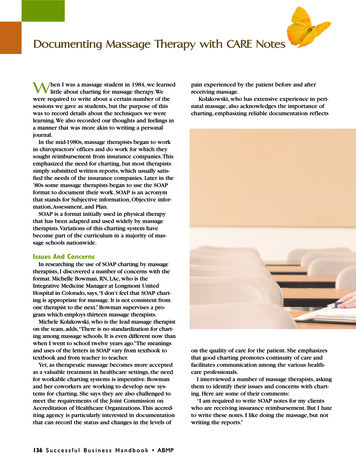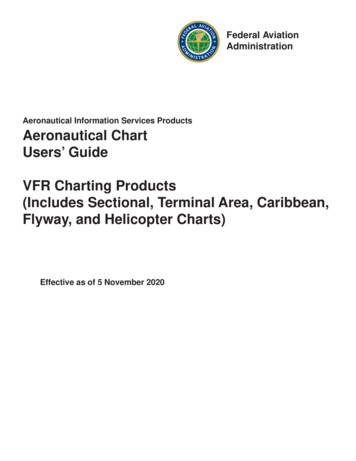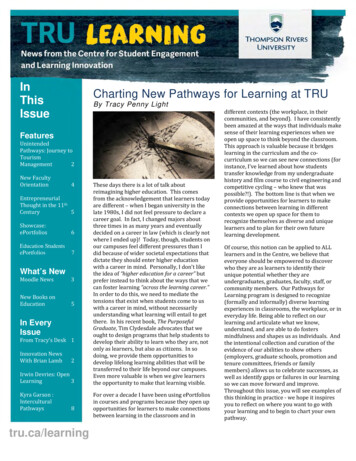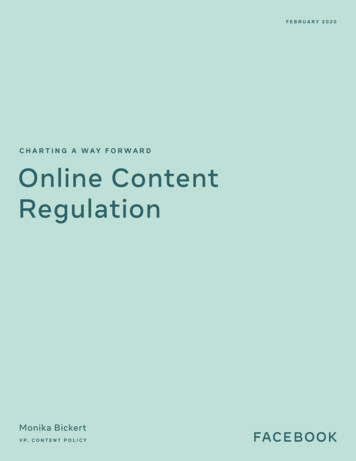
Transcription
FEBRUARY 2020C H A R T I N G A WAY F O R WA R DOnline ContentRegulationMonika BickertV P, C O N T E N T P O L I C YC H A R T I N G A WAY FO R WA R D1
Table of Contents03 I. A New Governance Challenge06 II. Four Key Questions09 Q U E S T I O N 1How can content regulation best achieve the goal ofreducing harmful speech while preserving free expression?10 Q U E S T I O N 2How should regulation enhance the accountability ofinternet platforms to the public?13 Q U E S T I O N 3Should regulation require internet companies to meetcertain performance targets?16 Q U E S T I O N 4Should regulation define which “harmful content” shouldbe prohibited on internet platforms?19 III. Principles for Future Regulators21 IV. The Beginning of a Conversation22 End NotesC H A R T I N G A WAY FO R WA R D2
01A New GovernanceChallengeBillions of people have come online in the past decade, gaining unprecedentedaccess to information and the ability to share their ideas and opinions with a wideaudience. Global connectivity has improved economies, grown businesses, reunitedfamilies, raised money for charity, and helped bring about political change. At thesame time, the internet has also made it easier to find and spread content that couldcontribute to harm, like terror propaganda. While this type of speech is not new,society’s increased reliance on the internet has shifted the power among those whocontrol and are affected by mass communication.For centuries, political leaders, philosophers, and activists have wrestled with thequestion of how and when governments should place limits on freedom ofexpression to protect people from content that can contribute to harm. Increasingly,privately run internet platforms are making these determinations, as more speechflows through their systems. Consistent with human rights norms, internet platformsgenerally respect the laws of the countries in which they operate, and they arealso free to establish their own rules about permissible expression, which are oftenmore restrictive than laws. As a result, internet companies make calls every daythat influence who has the ability to speak and what content can be shared ontheir platform.Problems arise when people do not understand the decisions that are being madeor feel powerless when those decisions impact their own speech, behavior, orexperience. People may expect similar due process channels to those that theyC H A R T I N G A WAY FO R WA R D3
01 A New Governance Challengeenjoy elsewhere in modern society. For example, people in liberal democracies mayexpect platforms to draft content standards with user and civil society input in mind,as well as the ability to seek redress if they feel a decision was made in error. Peopleare able to register preferences through market signals by moving to otherplatforms, but they may not be satisfied by this as their only option.As a result, private internet platforms are facing increasing questions about howaccountable and responsible they are for the decisions they make. They hear fromusers who want the companies to reduce abuse but not infringe upon freedomof expression. They hear from governments, who want companies to remove notonly illegal content but also legal content that may contribute to harm, but makesure that they are not biased in their adoption or application of rules. Facedwith concerns about bullying or child sexual exploitation or terrorist recruitment,for instance, governments may find themselves doubting the effectivenessof a company’s efforts to combat such abuse or, worse, unable to satisfactorilydetermine what those efforts are.This tension has led some governments to pursue regulation over the speechallowed online and companies’ practices for content moderation. The approachesunder consideration depend on each country’s unique legal and historical traditions.In the United States, for example, the First Amendment protects a citizen’s ability toengage in dialogue online without government interference except in the narrowestof circumstances. Citizens in other countries often have different expectations aboutfreedom of expression, and governments have different expectations about platformaccountability. Unfortunately, some of the laws passed so far do not alwaysstrike the appropriate balance between speech and harm, unintentionally pushingplatforms to err too much on the side of removing content.Facebook has therefore joined the call for new regulatory frameworks for onlinecontent—frameworks that ensure companies are making decisions about onlinespeech in a way that minimizes harm but also respects the fundamental rightto free expression. This balance is necessary to protect the open internet, whichis increasingly threatened—even walled off—by some regimes.Facebook wants to be a constructive partner to governments as they weigh themost effective, democratic, and workable approaches to address online contentgovernance. As Mark Zuckerberg wrote in a recent op-ed:It’s impossible to remove all harmful content from the Internet, but whenpeople use dozens of different sharing services—all with their own policiesand processes—we need a more standardized approach Regulationcould set baselines for what’s prohibited and require companies to buildsystems for keeping harmful content to a bare minimum.1C H A R T I N G A WAY FO R WA R D4
01 A New Governance ChallengeThis paper explores possible regulatory structures for content governanceoutside the United States and identifies questions that require further discussion.It builds off recent developments on this topic, including legislation proposed orpassed into law by governments, as well as scholarship that explains the variouscontent governance approaches that have been adopted in the past and may betaken in the future.2 Its overall goal is to help frame a path forward—taking intoconsideration the views not only of policymakers and private companies, but alsocivil society and the people who use Facebook’s platform and services.This debate will be central to shaping the character of the internet for decadesto come. If designed well, new frameworks for regulating harmful content cancontribute to the internet’s continued success by articulating clear, predictable, andbalanced ways for government, companies, and civil society to share responsibilitiesand work together. Designed poorly, these efforts may stifle expression, slowinnovation, and create the wrong incentives for platforms.C H A R T I N G A WAY FO R WA R D5
02Four Key QuestionsSince the invention of the printing press, developments in communicationstechnology have always been met with calls for state action. In the case of internetcompanies, however, it is uniquely challenging to develop regulation to ensureaccountability. There are four primary challenges.1. Legal environments and speech norms vary.Many internet companies have a global user base with a broad spectrumof expectations about what expression should be permitted online andhow decision makers should be held accountable. The cross-border natureof communication is also a defining feature of many internet platforms,so companies generally maintain one set of global policies rather thancountry-specific policies that would interfere with that experience.2. Technology and speech are dynamic.Internet services are varied and ever changing. Some are focused onvideo or images, while some are primarily text. Some types of internetcommunications are one-to-one and analogous to the private sphere,while others are more like a town square or broadcasting—where thousandsor millions of people can access the content in question. Some servicesare ephemeral, and some are permanent. Among these different interactiontypes, norms for acceptable speech may vary. Just as people may saythings in the privacy of a family dinner conversation that they would not sayat a town hall meeting, online communities cultivate their own norms thatare enforced both formally and informally. All are constantly changing tocompete and succeed.C H A R T I N G A WAY FO R WA R D6
02 Four Key Questions3. Enforcement will always be imperfect.Given the dynamic nature and scale of online speech, the limits ofenforcement technology, and the different expectations that people haveover their privacy and their experiences online, internet companies’enforcement of content standards will always be imperfect. Their abilityto review speech for policy or legal violations will always be limited. Evenin a hypothetical world where enforcement efforts could perfectly tracklanguage trends and identify likely policy violations, companies would stillstruggle to apply policies because they lack context that is often necessary,such as whether an exchange between two people is in jest or in anger, orwhether graphic content is posted for sadistic pleasure or to call attentionto an atrocity.4. Companies are intermediaries, not speakers.Publisher liability laws that punish the publication of illegal speech areunsuitable for the internet landscape. Despite their best efforts to thwartthe spread of harmful content, internet platforms are intermediaries,not the speakers, of such speech, and it would be impractical and harmfulto require internet platforms to approve each post before allowing it.The ability of individuals to communicate without journalistic interventionhas been central to the internet’s growth and positive impact. Imposingtraditional publishing liability would seriously curtail that impact by limitingthe ability of individuals to speak. Companies seeking assurance thattheir users’ speech is lawful would need to review and approve each postbefore allowing it to appear on the site. Companies that could afford tooffer services under such a model would be incentivized to restrict serviceto a limited set of users and err on the side of removing any speech closeto legal lines.Legal experts have cautioned that holding internet companies liable forthe speech of their users could lead to the end of these services altogether.As explained by Jennifer Granick, surveillance and cybersecurity counselat the American Civil Liberties Union, “There is no way you can have aYouTube where somebody needs to watch every video. There is no way youcan have a Facebook if somebody needs to watch every post. There wouldbe no Google if someone had to check every search result.” 3 Such liabilitywould stifle innovation as well as individuals’ freedom of expression. Thismodel’s flaws appear all the more clear in light of the significant effortsmany companies make to identify and remove harmful speech—efforts thatoften require the protective shield of intermediary liability protection laws.(Instead, as this paper explains, other models for regulating internetplatforms would better empower and encourage them to effectively addressharmful content.)C H A R T I N G A WAY FO R WA R D7
02 Four Key QuestionsThese challenges suggest that retrofitting the rules that regulate offlinespeech for the online world may be insufficient. Instead, new frameworks areneeded. This paper will put forward four questions that underpin the debateabout that framework:01 H ow can content regulation best achieve the goal of reducingharmful speech while preserving free expression?02 H ow should regulation enhance the accountability of internet platforms?03 Should regulation require internet companies to meet certainperformance targets?04 Should regulation define which “harmful content” should be prohibitedon internet platforms?C H A R T I N G A WAY FO R WA R D8
02 Four Key QuestionsQuestion 1: How can content regulation bestachieve the goal of reducing harmful speech whilepreserving free expression?While governments have different thresholds for limiting speech, the generalgoal of most content regulation is to reduce harmful speech while preserving freeexpression. Broadly speaking, regulation could aim to achieve this goal in threeways: (1) holding internet companies accountable for having certain systems andprocedures in place, (2) requiring companies meet specific performance targetswhen it comes to content that violates their policies, or (3) requiring companiesto restrict specific forms of speech, even if the speech is not illegal. The discussionof Questions 2, 3, and 4 will discuss these approaches in more detail.Facebook generally takes the view that the first approach—requiring companies tomaintain certain systems and procedures—is the best way to ensure an appropriatebalancing of safety, freedom of expression, and other values. By requiring systemssuch as user-friendly channels for reporting content or external oversight ofpolicies or enforcement decisions, and by requiring procedures such as periodicpublic reporting of enforcement data, regulation could provide governmentsand individuals the information they need to accurately judge social mediacompanies’ efforts.Governments could also consider requiring companies to hit specific performancetargets, such as decreasing the prevalence of content that violates a site’s hatespeech policies, or maintaining a specified median response time to user orgovernment reports of policy violations. While such targets may have benefits, theycould also create perverse incentives for companies to find ways to decreaseenforcement burdens, perhaps by defining harmful speech more narrowly, makingit harder for people to report possible policy violations, or stopping efforts toproactively identify violating content that has not been reported.Finally, regulators could require that internet companies remove certain content—beyond what is already illegal. Regulators would need to clearly define that content,and the definitions would need to be different from the traditional legal definitionsthat are applied through a judicial process where there is more time, more context,and independent fact-finders.These approaches are not mutually exclusive nor are they the only options.However, they do represent some of the most common ideas that we have heardin our conversations with policymakers, academics, civil society experts, andregulators. The approach a government may pursue will depend on what sort ofplatform behavior it wants to incentivize. Ultimately, the most important elementsof any system will be due regard for each of the human rights and values at stake,as well as clarity and precision in the regulation.C H A R T I N G A WAY FO R WA R D9
02 Four Key QuestionsQuestion 2: How should regulation enhance theaccountability of internet platforms to the public?People in democratic societies are accustomed to being able to hold theirgovernments accountable for their decisions. When internet companies makedecisions that have an impact on people’s daily lives, those people expect the sameaccountability. This is why internet companies, in their conversations with peopleusing their services, face questions like, “Who decides your content standards?,”“Why did you remove my post?,” and “What can I do to get my post reinstated whenyou make a mistake?”Regulation could help answer those questions by ensuring that internet contentmoderation systems are consultative, transparent, and subject to meaningfulindependent oversight. Specifically, procedural accountability regulations couldinclude, at a minimum, requirements that companies publish their contentstandards, provide avenues for people to report to the company any contentthat appears to violate the standards, respond to such user reports with adecision, and provide notice to users when removing their content from the site.Such regulations could require a certain level of performance in these areas toreceive certifications or to avoid regulatory consequences.Regulation could also incentivize—or where appropriate, require—additionalmeasures such as:Insight into a company’s development of its content standards.A requirement to consult with stakeholders when making significantchanges to standards.An avenue for users to provide their own input on content standards.A channel for users to appeal the company’s removal (or non-removal)decision on a specific piece of content to some higher authority withinthe company or some source of authority outside the company.Public reporting on policy enforcement (possibly including how muchcontent was removed from the site and for what reasons, how much contentwas identified by the company through its own proactive means beforeusers reported it, how often the content appears on its site, etc.).Regulations of this sort should take into account a company’s size and reach,as content regulation should not serve as a barrier to entry for new competitorsin the market.C H A R T I N G A WAY FO R WA R D10
02 Four Key QuestionsAn important benefit of this regulatory approach is that it incentivizes anappropriate balancing of competing interests, such as freedom of expression, safety,and privacy. Required transparency measures ensure that the companies’ balancingefforts are laid bare for the public and governments to see.If they pursued this approach, regulators would not be starting from scratch; theywould be expanding and adding regulatory effect to previous efforts of governments,civil society, and industry. For example, the Global Network Initiative Principles 4and other civil society efforts have helped create baselines for due process andtransparency linked to human rights principles. The GNI has also created anincentives structure for compliance. Similarly, the European Union Code of Conducton Countering Illegal Hate Speech Online has created a framework that has led toall eight signatory companies meeting specific requirements for transparency anddue process.In adopting this approach, however, regulators must be cautious. Specific productdesign mandates—“put this button here,” “use this wording,” etc.—will make it harderfor internet companies to test what options work best for users. It will also makeit harder for companies to tailor the reporting experience to the device being used:the best way to report content while using a mobile phone is likely to differ fromthe best way to report content while using a laptop. In fact, we have found thatcertain requests from regulators to structure our reporting mechanisms in specificways have actually reduced the likelihood that people will report dangerouscontent to us quickly.Another key component of procedural accountability regulation is transparency.Transparency, such as required public reporting of enforcement efforts, wouldcertainly subject internet companies to more public scrutiny, as their work would beavailable for governments and the public to grade. This scrutiny could have bothpositive and negative effects.The potential negative effects could arise from the way transparency requirementsshape company incentives. If a company feared that people would judge harshly ofits efforts and would therefore stop using or advertising on its service, the companymight be tempted to sacrifice in unmeasured areas to help boost performance inmeasured areas. For instance, if regulation required the measuring and publicannual reporting of the average time a company took to respond to user reports ofviolating content, a company might sacrifice quality in its review of user reports inorder to post better numbers. If regulation required public reporting of how manytimes users appealed content removal decisions, a company might make its appealchannel difficult to find or use.On the other hand, companies taking a long-term view of their business incentiveswill likely find that public reactions to their transparency efforts—even if painfulat times—can lead them to invest in ways that will improve public and governmentC H A R T I N G A WAY FO R WA R D11
02 Four Key Questionsconfidence in the longer term. For example, spurred by multi-stakeholder initiativeslike GNI or the EU Code of Conduct mentioned above, Facebook has increasedefforts to build accountability into our content moderation process by focusing onconsultation, transparency, and oversight. In response to reactions to our reports,we have sought additional input from experts and organizations.Going forward, we will continue to work with governments, academics, and civilsociety to consider what more meaningful accountability could look like in thisspace. As companies get better at providing this kind of transparency, people andgovernments will have more confidence that companies are improving theirperformance, and people will be empowered to make choices about which platformto use—choices that will ultimately determine which services will be successful.C H A R T I N G A WAY FO R WA R D12
02 Four Key QuestionsQuestion 3: Should regulation require internetcompanies to meet certain performance targets?Governments could also approach accountability by requiring that companies meetspecific targets regarding their content moderation systems. Such an approachwould hold companies accountable for the ends they have achieved rather thanensuring the validity of how they got there.For example, regulators could say that internet platforms must publish annual dataon the “prevalence” of content that violates their policies, and that companies mustmake reasonable efforts to ensure that the prevalence of violating content remainsbelow some standard threshold. If prevalence rises above this threshold, then thecompany might be subject to greater oversight, specific improvement plans, or—inthe case of repeated systematic failures—fines.Regulators pursuing this approach will need to decide which metrics to prioritize.That choice will determine the incentives for internet companies in how theymoderate content. The potential for perverse incentives under this model is greaterthan under the procedural accountability model, because companies withunsatisfactory performance reports could face direct penalties in the form of finesor other legal consequences, and will therefore have a greater incentive to shortcutunmeasured areas where doing so could boost performance in measured areas.Governments considering this approach may also want to consider whether andhow to establish common definitions—or encourage companies to do so—to be ableto compare progress across companies and ensure companies do not tailor theirdefinitions in such a way to game the metrics.With that in mind, perhaps the most promising area for exploring the developmentof performance targets would be the prevalence of violating content (how muchviolating content is actually viewed on a site) and the time-to-action (how long thecontent exists on the site before removal or other intervention by the platform).Prevalence: Generally speaking, some kinds of content are harmful only tothe extent they are ever actually seen by people. A regulator would likelycare more about stopping one incendiary hateful post that would be seen bymillions of people than twenty hateful posts that are seen only by the personwho posted them. For this reason, regulators (and platforms) will likely bebest served by a focus on reducing the prevalence of views of harmfulcontent. Regulators might consider, however, the incentives they might beinadvertently creating for companies to more narrowly define harmfulcontent or to take a minimalist approach in prevalence studies.Time-to-Action: By contrast, some types of content could be harmful evenwithout an audience. In the case of real-time streaming of child sexualC H A R T I N G A WAY FO R WA R D13
02 Four Key Questionsexploitation, coordination of a violent attack, or an expressed plan to harmoneself, quick action is often necessary to save lives, and the weighing ofvalues may be so different as to justify an approach that incentivizes fastdecision-making even where it may lead to more incorrect content removals(thus infringing on legitimate expression) or more aggressive detectionregimes (such as in the case of using artificial intelligence to detect threatsof self harm, thus potentially affecting privacy interests).There are significant trade-offs regulators must consider when identifying metricsand thresholds. For example, a requirement that companies “remove all hate speechwithin 24 hours of receiving a report from a user or government” may incentivizeplatforms to cease any proactive searches for such content, and to instead usethose resources to more quickly review user and government reports on a firstin-first-out basis. In terms of preventing harm, this shift would have serious costs.The biggest internet companies have developed technology that allows them todetect certain types of content violations with much greater speed and accuracythan human reporting. For instance, from July through September 2019, the vastmajority of content Facebook removed for violating its hate speech, self-harm,child exploitation, graphic violence, and terrorism policies was detected by thecompany’s technology before anyone reported it. A regulatory focus on responseto user or government reports must take into account the cost it would pose tothese company-led detection efforts.Even setting aside proactive detection, a model that focuses on average time-toaction of reported content would discourage companies from focusing on removalof the most harmful content. Companies may be able to predict the harmfulness ofposts by assessing the likely reach of content (through distribution trends and likelyvirality), assessing the likelihood that a reported post violates (through review withartificial intelligence), or assessing the likely severity of reported content (such as ifthe content was reported by a safety organization with a proven record of reportingonly serious violations). Put differently, companies focused on average speed ofassessment would end up prioritizing review of posts unlikely to violate or unlikelyto reach many viewers, simply because those posts are closer to the 24-hourdeadline, even while other posts are going viral and reaching millions.A regulation requiring companies to “remove all hate speech within 24 hoursof upload” would create still more perverse incentives. Companies would have astrong incentive to turn a blind eye to content that is older than 24 hours (andunlikely to be seen by a government), even though that content could be causingharm. Companies would be disincentivized from developing technology that canidentify violating private content on the site, and from conducting prevalencestudies of the existing content on their site.The potential costs of this sort of regulation can be illustrated through a review ofFacebook’s improvements in countering terror propaganda. When Facebook firstC H A R T I N G A WAY FO R WA R D14
02 Four Key Questionsbegan measuring its average time to remove terror propaganda, it had technicalmeans to automatically identify some terror propaganda at the time of upload.After considerable time and effort, Facebook engineers developed better detectiontools, including a means for identifying propaganda that had been on the site foryears. Facebook used this tool to find and remove propaganda, some of which hadlong existed on the site without having been reported by users or governments.This effort meant that Facebook’s measurement of average time on site for terrorpropaganda removed went up considerably. If Facebook would have facedconsequences for an increase in its “time-to-action,” it would have beendiscouraged from ever creating such a tool.Whichever metrics regulators decide to pursue, they would be well servedto first identify the values that are at stake (such as safety, freedom ofexpression, and privacy) and the practices they wish to incentivize, and thenstructure their regulations in a way that minimizes the risk of perverseincentives. This would require close coordination among various regulatorsand policymaking bodies focused on sometimes competing interests, such asprivacy, law enforcement, consumer protection, and child safety. A regulationthat serves the regulatory interests of one body well may in fact harm theinterests of another.C H A R T I N G A WAY FO R WA R D15
02 Four Key QuestionsQuestion 4: Should regulation define which “harmfulcontent” should be prohibited on internet platforms?Many governments already have in place laws and systems to define illegal speechand notify internet platforms when illegal speech is present on their services.Governments are also considering whether to develop regulations that specificallydefine the “harmful content” internet platforms should remove—above and beyondspeech that is already illegal.International human rights instruments provide the best starting point for analysisof government efforts to restrict speech. Article 19 of the International Covenanton Civil and Political Rights (ICCPR) 5 holds:1. Everyone shall have the right to hold opinions without interference.2. Everyone shall have the right to freedom of expression; this right shallinclude freedom to seek, receive and impart information and ideas ofall kinds, regardless of frontiers, either orally, in writing or in print, in theform of art, or through any other media of his choice.3. The exercise of the rights provided for in paragraph 2 of this article carrieswith it special duties and responsibilities. It may therefore be subjectto certain restrictions, but these shall only be such as are provided by lawand are necessary:(a) For respect of the rights or reputations of others;(b) For the protection of national security or of public order(ordre public), or of public health or morals.Similarly, Article 10 of the European Convention on Human Rights carves out roomfor governments to pass speech laws that are necessary for: [T]he interests of national security, territorial integrity or public safety,for the prevention of disorder or crime, for the protection of health or morals,for the protection of the reputation or rights of others, for preventingthe disclosure of information received in
and individuals the information they need to accurately judge social media companies' efforts. Governments could also consider requiring companies to hit specific performance . CHARTING A A FORWARD. CHARTING A A FORWARD. CHARTING A A FORWARD. CHARTING A A FORWARD. CHARTING A A FORWARD. 6.
